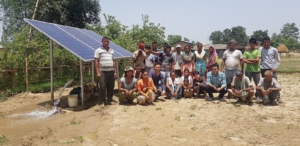5 Sustainable Technologies Solving Water Scarcity

More than 1 billion people live in areas with water scarcity or the lack of access to freshwater resources. However, current innovations are tackling water scarcity in creative and environmentally friendly ways. Here are five sustainable technologies solving water scarcity.
5 Sustainable Technologies Solving Water Scarcity
- Solar-powered Water Pumps: These pumps use energy from the sun to power electric pumps, which extract water from the ground. The price and technology have evolved in recent years, allowing solar-powered water pumps to be a more affordable, reliable and environmentally sustainable solution to water scarcity. Solar panels last approximately 25 years, requiring little maintenance throughout this lifetime. Also, the cost of solar panels that the pumps use has decreased by 80 percent. Solar-powered water pumps are most viable in areas with high solar insolation, particularly, many developing nations in Africa, South America and South Asia. Specifically, solar-powered water pumps have alleviated water scarcity for 40,000 people in Marimanti, Kenya, a country with annual sunshine.
- Solar-powered Desalination Units: Desalination technology harnesses energy from the sun and converts seawater into fresh, potable water. A system that Solar Water Solutions, a Finland-based startup, designed produces up to 3,500 liters of water per hour. Additionally, the system does not require batteries or oil-based fuel and it does not impart a large carbon footprint. Additionally, Solar Water Solutions has placed solar-powered desalination units in Kenya and Namibia. The desalination units are providing cheap, clean water to local communities. Additionally, large scale implementation of the technology could help solve water scarcity.
- Fog Catchers: Mesh nets trap freshwater from fog and eventually drips into the collection trays. A piping network then carries the water to the village. This system is free, clean and environmentally sustainable. People are using fog catching systems to provide water to communities in Chile, Peru, Ghana, South Africa and more. The largest fog catcher project is on the slopes of Mount Boutmezguida in southern Morocco. Every day, about 1,000 people use water that fog captured for everything from drinking to agricultural use.
- Portable Filters: In particular, one Swiss company, Vestergaard Frandsen, has developed a portable water filter. Lifestraw is a gravity-powered plastic tube, that people can use as a drinking straw. The filtration system eliminates protozoa, bacteria, chemical compounds and dissolved metals. Each Lifestraw can filter up to 4,000 liters of water — enough potable water to last three years for one person. Additionally, this portable filter eliminates the need for single-use plastics and fuel-combustion for water sanitization. Further, LifeStraw has partnered with the World Health Organization and the United Nations to alleviate the shortage of potable water for more than 64 countries, including Haiti, Rwanda and Kenya.
- Drinkable Books: Each page of the drinkable book is a filter that turns raw sewage into potable water. The drinkable book houses silver and/or copper nanoparticles that kill bacteria when water passes through it. Motivated by a desire to create a water filtration system that uses greener chemistry, researchers designed the tool at Carnegie Mellon University. Field trials have shown that the drinkable book can eliminate 99 percent of bacteria in water. At the 25 contaminated water sources in South Africa, Ghana, Kenya, Haiti and Bangladesh, these trials have been promising enough that people can distribute the drinkable book commercially. Each book holds enough filtration sheets to filter clean water for four years.
For the millions of people across the globe lacking access to clean water, these are five sustainable technologies solving water scarcity. Technology like these has the potential to make a substantial difference in the world in terms of sustainable solutions for sanitation and access to water.
– Kayleigh Rubin
Photo: Wikimedia
